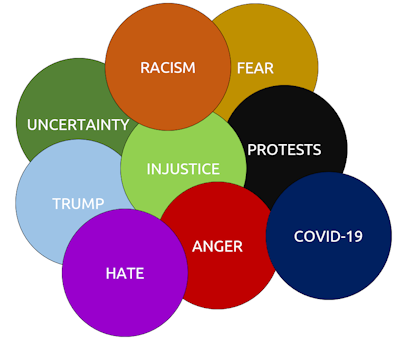Theories of Change
by Heidi Burgess and Guy Burgess
June 28, 2020
David Brooks, a New York Times columnist, recently wrote a column complaining that current activists need a theory of change. The term "theory of change" is not one I heard until I was in graduate school, and even then it took me awhile to figure out what it meant. But it is a critical concept and I was delighted to see it in one of Brooks' columns. (He wrote a related column in 2010 which is also excellent and still applies today.)
I now find it easiest to explain theories of change to my students with an example most of us (at least most women and some men) have experienced—dieting to lose weight.
There are lots of theories about how one can lose weight. The old fashioned one (that has actually worked for me recently!) is to cut down on the calorie intake (by cutting out cookies and ice cream, for instance) while increasing one's calorie expenditure with exercise. The more the calories expended exceed the calories consumed, the greater the weight loss (or so the theory goes). But lots of people say that doesn't work, because the body just alters its metabolism to adjust and maintain its "desired" original weight. So they've come up with alternative theories: the paleo diet, the vegan diet, the low carb diet, the low-fat diet, etc. Each of these diets is, in essence, a theory of change—a theory of what one should do if one wants to change one's weight.
Just as we need a theory of change to lose weight, we need a theory of change to accomplish any other goal. Often we need a combination of approaches—multiple theories of change. Take, for example, overcoming COVID-19. There are lots of theories of change floating around—make everyone stay home, get people to "social distance," get everyone to wear masks, give people Hydroxychloroquine (a malaria drug hyped by President Trump), etc. Unfortunately, there are so many competing theories of change being advocated, and so little trust in anyone doing the advocating, that we are getting a mish-mash of responses, and, as a result, the virus is again (as I write this) surging in terrifying ways.
| We need a theory of change about how to end (or even reduce) systemic racism in this—country starting (perhaps) with police departments, but then moving into society as a whole. |
We also need a theory of change about how to end (or even reduce) systemic racism in this country—starting (perhaps) with police departments, but then moving into society as a whole. The most widely used theories at the moment seem to be focused on nonviolent (and sometimes violent) direct action: protests demanding "defunding the police" or, at least, a radical funding shift away from law enforcement toward social services. Others are focused on tearing down statues depicting past dignitaries who held slaves or did other objectionable things—such as a statue of Junipero Serra who founded nine Catholic missions in California and converted (often through force) thousands of native Californians to Christianity. The theory of change behind these acts is less clear and probably less effective. While it may have some effect on how we collectively see our flawed history, it could also spark a backlash by those who see it as an act of vandalism directed at people who, despite their flaws, did genuinely praiseworthy things.
Beyond Intractability has an excellent article written by Ilana Shapiro discussing many different theories of change that might actually be useful as we
| Tearing down statues is a weak and, quite possibly, counterproductive theory (or practice) of change. |
confront these two challenges (COVID-19 and racism). It doesn't include medical theories of change for confronting viruses, but it does include many theories of change for changing people's behavior when they are torn by racial and ethnic tensions. So the article directly relates to our current reaction to the George Floyd killing, and it also relates to the polarized nature of our response to COVID-19. Guy and I have —asserted and most of the other people posting on this blog—agree that if we are going to survive COVID-19, we need to start working together across the political spectrum. The theories of change presented in Shapiro's article relate to how to do that too—as well as how to reduce racial and ethnic tensions.
Caveat--Shapiro's is a long article, but it is well worth the time. And if you want a quick but very valuable preview, just look at two of the figures she presents: Figure 1: [A] Typology of Theories of Practice and Change for U.S. Conflict Interventions [in Racial and Ethnic Conflicts] and Figure 2: Example of Healing and Reconciliation Theory of Practice and Change Flowchart.








